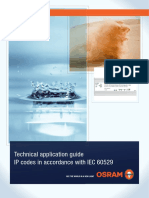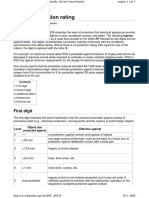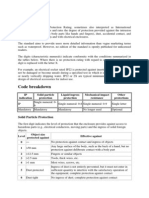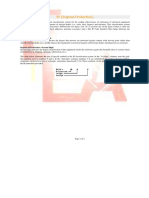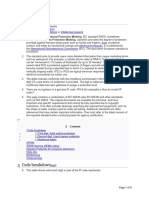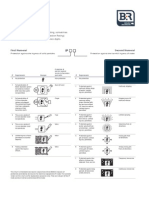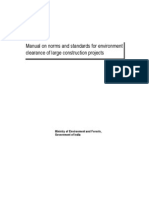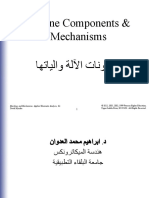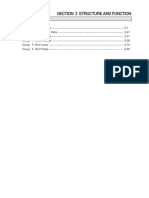Ingress Protection Rating: First Digit
Ingress Protection Rating: First Digit
Uploaded by
lanikhilCopyright:
Available Formats
Ingress Protection Rating: First Digit
Ingress Protection Rating: First Digit
Uploaded by
lanikhilOriginal Title
Copyright
Available Formats
Share this document
Did you find this document useful?
Is this content inappropriate?
Copyright:
Available Formats
Ingress Protection Rating: First Digit
Ingress Protection Rating: First Digit
Uploaded by
lanikhilCopyright:
Available Formats
Ingress protection rating
International standard IEC 60529 classifies the level of protection that electrical appliances provide against the intrusion of solid objects or dust, accidental contact, and water. The resulting ingress protection rating is identified by a code that consists of the letters IP followed by two digits and an optional letter. The digits ('characteristic numerals') indicate conformity with the conditions summarized in the tables below. Where there is no protection rating with regard to one of the criteria, the digit is replaced with the letter X. For example, an electrical socket rated IP22 is protected against insertion of fingers and will not be damaged or become unsafe when exposed to vertically or nearly vertically dripping water. IP22 or IP2X are typical minimum requirements for the design of electrical accessories for in-door use. One source reports that the Australian national standard AS 1939 adds to the international standard a third optional digit, which indicates protection against mechanical impact damage. It ranges from 0 for no protection to 9 for protection against 20 joule impacts (equivalent to 5 kg dropped from 40 cm). First digit The first digit indicates the level of protection that the enclosure provides against access to hazardous parts (e.g., electrical conductors, moving parts) and the ingress of solid foreign objects. Object size Level Effective against protected against 0 1 2 3 4 5 6 >50 mm >12.5 mm >2.5 mm >1 mm dust protected dust tight no protection against contact and ingress of objects any large surface of the body, such as the back of a hand, but no protection against deliberate contact with a body part fingers or similar objects tools, thick wires, etc. most wires, screws, etc. ingress of dust is not entirely prevented, but it must not enter in sufficient quantity to interfere with the satisfactory operation of the equipment; complete protection against contact no ingress of dust; complete protection against contact
Second digit Protection of the equipment inside the enclosure against harmful ingress of water.
Level Protected against 0 1 2 3 4 5 6 7 8 not protected dripping water
Details Dripping water (vertically falling drops) shall have no harmful effect.
dripping water when Vertically dripping water shall have no harmful effect when the enclosure is tilted up to 15 tilted at an angle up to 15 from its normal position. spraying water splashing water water jets heavy seas the effects of immersion submersion Water falling as a spray at any angle up to 60 from the vertical shall have no harmful effect. Water splashing against the enclosure from any direction shall have no harmful effect. Water projected by a nozzle against enclosure from any direction shall have no harmful effects. Water from heavy seas or projected in powerful jets shall not enter the enclosure in harmful quantities. Ingress of water in harmful quantity shall not be possible when the enclosure is immersed in water under defined conditions of pressure and time. The equipment is suitable for continuous submersion in water under conditions which shall be specified by the manufacturer. NOTE: Normally, this will mean that the equipment is hermetically sealed. However, with certain types of equipment, it can mean that water can enter but only in such a manner that produces no harmful effects.
Next page gives you Ready refernce of IP ratings.
Additional letters
The standard defines additional letters that can be appended to classify only the level of protection against access to hazardous parts by persons:
Level A B C D
Protected against access to hazardous parts with back of hand finger Tool wire
Further letters can be appended to provide additional information related to the protection of the device: Letter Meaning H M S W high voltage device device moving during water test device standing still during water test weather conditions
You might also like
- Siemens Mechatronic Systems Certification Program: Test QuestionsDocument22 pagesSiemens Mechatronic Systems Certification Program: Test QuestionsIsaac Gisore100% (1)
- Iec 60529Document9 pagesIec 60529wawan100% (1)
- IP Standards: Solids, First DigitDocument2 pagesIP Standards: Solids, First DigitSankalp MittalNo ratings yet
- Ingress Protection Rating) Consists of The Letters IP Followed by Two Digits and AnDocument7 pagesIngress Protection Rating) Consists of The Letters IP Followed by Two Digits and Anajaygupta150No ratings yet
- Ingress Protection Rating - Wikipedia, The Free EncyclopediaDocument6 pagesIngress Protection Rating - Wikipedia, The Free EncyclopediaChoirul MustofaNo ratings yet
- IP Codes: International Standard IEC Electrical EnclosuresDocument3 pagesIP Codes: International Standard IEC Electrical EnclosuresNATHANNo ratings yet
- Ip Codes (Reference)Document2 pagesIp Codes (Reference)UNNI VENUGOPALNo ratings yet
- Pass Ip CodesDocument1 pagePass Ip CodesDavid WattsNo ratings yet
- Explanation of The Letters IP Is Given in IEC 60529 (Ed. 2.1), Clause 4.1Document1 pageExplanation of The Letters IP Is Given in IEC 60529 (Ed. 2.1), Clause 4.1Richie Brian StephenNo ratings yet
- IP-Ik Code - WikipediaDocument4 pagesIP-Ik Code - Wikipediatenk_manNo ratings yet
- Protection Degree According IEC 60529Document3 pagesProtection Degree According IEC 60529Stefanita100% (1)
- Deg Prot Is, Iec-IpDocument1 pageDeg Prot Is, Iec-IptceterexNo ratings yet
- Ingress Protection (IP)Document2 pagesIngress Protection (IP)nileshb1985No ratings yet
- Ingress Protection RatingDocument5 pagesIngress Protection RatingmshahidshaukatNo ratings yet
- Solids, First Digit Ip CodesDocument1 pageSolids, First Digit Ip CodesManish ChristianNo ratings yet
- Modes of Protection As Per DIN VDE 0470-1 (EN 60529) Degrees of Protection Against Solid Foreign Bodies Degrees of Protection Against WaterDocument1 pageModes of Protection As Per DIN VDE 0470-1 (EN 60529) Degrees of Protection Against Solid Foreign Bodies Degrees of Protection Against WaterKhaled ElsheikhNo ratings yet
- IP Rating Chart - DSMTDocument18 pagesIP Rating Chart - DSMTAbi Putra100% (1)
- Icos Sensors Protection IPDocument2 pagesIcos Sensors Protection IPIcos Sensores para LíquidosNo ratings yet
- IP Rating ChartDocument5 pagesIP Rating Charthemant kumarNo ratings yet
- IP Code StandardsDocument5 pagesIP Code StandardsPuneet SharmaNo ratings yet
- EDP Lab ManualDocument29 pagesEDP Lab Manualkulshrestha.kartik17No ratings yet
- IP CodeDocument6 pagesIP CodeYousif AbdalhalimNo ratings yet
- IP Code MeaningsDocument2 pagesIP Code MeaningskhscribeNo ratings yet
- IP Rating1Document1 pageIP Rating1sesabcdNo ratings yet
- IP Code: Explanation of The Letters IP Is Given in IEC 60529 (Ed. 2.1), Clause 4.1Document6 pagesIP Code: Explanation of The Letters IP Is Given in IEC 60529 (Ed. 2.1), Clause 4.1Shannon GarciaNo ratings yet
- IP Rating Chart Index Protection PDFDocument17 pagesIP Rating Chart Index Protection PDFbens17No ratings yet
- IPDegree-Engineer Must KnowDocument1 pageIPDegree-Engineer Must Knowraveekas6148No ratings yet
- Degrees of Protection: 1. The IEC Protection Code (International Protection IP)Document11 pagesDegrees of Protection: 1. The IEC Protection Code (International Protection IP)Bobot PadilloNo ratings yet
- Degree of Protection of MotorsDocument2 pagesDegree of Protection of Motorsperfectman_007No ratings yet
- Ip6 StandardDocument2 pagesIp6 StandardAmaresh DashNo ratings yet
- Ingress Protection (IP) and What It Means: First Digit: SolidsDocument7 pagesIngress Protection (IP) and What It Means: First Digit: SolidsLeroy AraoNo ratings yet
- IP Rating ChartDocument11 pagesIP Rating Chartchak1729No ratings yet
- Determining The Degree of Protection: Simplified Design GuideDocument2 pagesDetermining The Degree of Protection: Simplified Design GuideABELWALIDNo ratings yet
- IP Code - Wikipedia PDFDocument6 pagesIP Code - Wikipedia PDFAnthonia OgbechieNo ratings yet
- IP (Ingress Protection) : Degrees of Protection-First DigitDocument3 pagesIP (Ingress Protection) : Degrees of Protection-First DigitMuhd HuzaiNo ratings yet
- I P CodeDocument3 pagesI P CodevirendkumarNo ratings yet
- Technical Application Guide Ip Codes in Accordance With Iec 60529 GBDocument9 pagesTechnical Application Guide Ip Codes in Accordance With Iec 60529 GBFrankGriffith100% (1)
- Ingress Protection (IP)Document1 pageIngress Protection (IP)Jimmi VakilNo ratings yet
- IP Rating Chart: Learn What IP Means and What Rating Is Best For Your ApplicationDocument19 pagesIP Rating Chart: Learn What IP Means and What Rating Is Best For Your ApplicationMichael CincoNo ratings yet
- Ip Ratings ExplainedDocument4 pagesIp Ratings ExplainedMarsal CMNo ratings yet
- IP Rated Enclosures Explained: What Is An IP Rating?Document2 pagesIP Rated Enclosures Explained: What Is An IP Rating?Mohammadshoaib27No ratings yet
- IP ExplanationDocument1 pageIP ExplanationBeth PasaribuNo ratings yet
- IP Equivalent NEMADocument1 pageIP Equivalent NEMAdvaccarielloNo ratings yet
- Technical Data - IP Protection Classification IEC 529Document1 pageTechnical Data - IP Protection Classification IEC 529sssf-dobojNo ratings yet
- Ingress Protection (IP)Document9 pagesIngress Protection (IP)sara anassNo ratings yet
- IP Rating: First Digit: SolidsDocument8 pagesIP Rating: First Digit: Solidsanthony santidadNo ratings yet
- Technical Application Guide - Ip Codes in Accordance With Iec 60529 GBDocument14 pagesTechnical Application Guide - Ip Codes in Accordance With Iec 60529 GBismet nasNo ratings yet
- IP CodesDocument9 pagesIP CodesSaDia AshrafNo ratings yet
- IP69K DescriptionDocument8 pagesIP69K DescriptionTony PaiNo ratings yet
- IP Rating ChartDocument1 pageIP Rating ChartziaflyNo ratings yet
- Ingress Protection Codes: First Digit-Protection Against Solid Objects Second Digit-Protection Against LiquidsDocument1 pageIngress Protection Codes: First Digit-Protection Against Solid Objects Second Digit-Protection Against LiquidsMomtaz MoniNo ratings yet
- IP Ratings Explained PDFDocument2 pagesIP Ratings Explained PDFdanielliram993No ratings yet
- Definition of Degrees of Protection: IP IKDocument1 pageDefinition of Degrees of Protection: IP IKAngel Loza PeñaNo ratings yet
- Degrees of ProtectionDocument13 pagesDegrees of ProtectionSolange Fernández GomesNo ratings yet
- Ip Rating ChartDocument1 pageIp Rating ChartVineeth KrishnarajNo ratings yet
- IP Stands For Ingress ProtectionDocument1 pageIP Stands For Ingress ProtectionBranka MilutinovicNo ratings yet
- VFD Enclosure IP RatingsDocument2 pagesVFD Enclosure IP RatingstrueavatharNo ratings yet
- Protection Classes of Electrical Connection boxesEN20140218Document5 pagesProtection Classes of Electrical Connection boxesEN20140218Liviu PetreusNo ratings yet
- Ingress Protection (Ip) Ratings To As 1939 (Iec 529)Document1 pageIngress Protection (Ip) Ratings To As 1939 (Iec 529)farzamNo ratings yet
- API Focussed Mhra Inspections at Dosage Form MFGDocument9 pagesAPI Focussed Mhra Inspections at Dosage Form MFGlanikhilNo ratings yet
- Construction ManualDocument256 pagesConstruction ManualMadhav V UpadhyeNo ratings yet
- GMP Expectation of Non Traditional API - MhraDocument1 pageGMP Expectation of Non Traditional API - Mhralanikhil0% (1)
- Water For Pharmaceutical Use: Commissioning, Qualification and ValidationDocument16 pagesWater For Pharmaceutical Use: Commissioning, Qualification and ValidationlanikhilNo ratings yet
- LT Panels - BoqDocument4 pagesLT Panels - BoqlanikhilNo ratings yet
- Single Line Drawing of PCC PanelDocument1 pageSingle Line Drawing of PCC Panellanikhil100% (2)
- Hvac Part2Document29 pagesHvac Part2lanikhilNo ratings yet
- Boiler Feed WaterDocument1 pageBoiler Feed WaterlanikhilNo ratings yet
- Bearing GuideDocument176 pagesBearing GuideJay_CRENo ratings yet
- LED Solutions Catalogue 2011Document537 pagesLED Solutions Catalogue 2011stewart_douglas574No ratings yet
- Uen R 63900001Document8 pagesUen R 63900001ivanNo ratings yet
- Act Series Control Panel and MB Door Board Connection DiagramDocument1 pageAct Series Control Panel and MB Door Board Connection DiagramJavier Martínez100% (1)
- Camden CV-TAC4WC Data SheetDocument4 pagesCamden CV-TAC4WC Data SheetJMAC SupplyNo ratings yet
- Indoor Oxygen Monitor: Model OX 600Document2 pagesIndoor Oxygen Monitor: Model OX 600Victor AndreiNo ratings yet
- A. Supply & Maintenance of It Materials: Vendor List of SLDC For The Financial Year 2016-17Document8 pagesA. Supply & Maintenance of It Materials: Vendor List of SLDC For The Financial Year 2016-17Priya ShindeNo ratings yet
- Messko MTO Oil Level Indicator For TransformersDocument6 pagesMessko MTO Oil Level Indicator For TransformersMatias RiedelNo ratings yet
- Penn Union 1-Hole (Long Barrel)Document2 pagesPenn Union 1-Hole (Long Barrel)khalidNo ratings yet
- Case 9330Document1,524 pagesCase 9330Nicolas AlegreNo ratings yet
- Keeway Focus Matrix Electrical System SchemaDocument12 pagesKeeway Focus Matrix Electrical System SchemaugoranNo ratings yet
- Sonarwire Global, LLC: Providing Sonar Surveys Since 1984Document4 pagesSonarwire Global, LLC: Providing Sonar Surveys Since 1984VICTOR ALFONSO GARCIA LOPEZNo ratings yet
- Margaret Salmon - An Artists' Guide To Analogue CinematographyDocument25 pagesMargaret Salmon - An Artists' Guide To Analogue CinematographyMarcus Philippe MarquesNo ratings yet
- Kidde Aegis Conventional Fire Control PanelDocument18 pagesKidde Aegis Conventional Fire Control PanelRahul Deva100% (1)
- Fopx 610TFD-24 SPCDocument74 pagesFopx 610TFD-24 SPCFawllyn Guevara100% (1)
- Desoutter - Service Manual 2004Document3 pagesDesoutter - Service Manual 2004Danniel Schaaf0% (1)
- IPVA10EK Air Admit Valve: Features & Benefits DimensionsDocument1 pageIPVA10EK Air Admit Valve: Features & Benefits DimensionsgirardNo ratings yet
- Catalgo de Pzas RidgidDocument172 pagesCatalgo de Pzas RidgidJonathan RecinosNo ratings yet
- Machine Components - pptx1Document272 pagesMachine Components - pptx1Almajd MustafaNo ratings yet
- Panamax MAX 5300 Owner's Manual (INS5300D)Document14 pagesPanamax MAX 5300 Owner's Manual (INS5300D)Bruno da CostaNo ratings yet
- 49CMTV WRFDocument4 pages49CMTV WRFelayarajanNo ratings yet
- Section 2 Structure and FunctionDocument21 pagesSection 2 Structure and Functionjulio cesarNo ratings yet
- European Standard En779 2012 The Standard For Air Filter EfficiencyDocument1 pageEuropean Standard En779 2012 The Standard For Air Filter EfficiencyAdan FilterNo ratings yet
- Denon dnm1050r ManualDocument46 pagesDenon dnm1050r ManualNikola NikolićNo ratings yet
- Wiring & Cable Color SchemeDocument4 pagesWiring & Cable Color Schemeluis.b.guerrero4779No ratings yet
- Type of GlassDocument2 pagesType of GlassNoor FarihanNo ratings yet
- Countersunk Screw With Hexagon Socket Head ISO 10642 Steel 8.8Document9 pagesCountersunk Screw With Hexagon Socket Head ISO 10642 Steel 8.8Alex DeschevogNo ratings yet
- Quick Start Guide: Adventurer 3 / 冒险家 3Document20 pagesQuick Start Guide: Adventurer 3 / 冒险家 3Patrick ClearskiesnlNo ratings yet
- Ultra1000 LEL CombustibleDocument2 pagesUltra1000 LEL Combustiblececilia aguilarNo ratings yet
- Compact Vet3 WebDocument2 pagesCompact Vet3 WebJairo ManzanedaNo ratings yet
- SWA Brochure Hi-Res - 2015 PDFDocument210 pagesSWA Brochure Hi-Res - 2015 PDFhatemNo ratings yet

